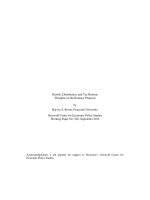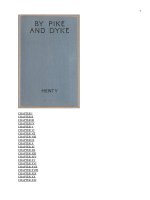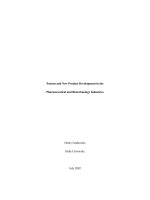AN0892 fail safe monitoring and clock frequency switching using the PIC16F684
Bạn đang xem bản rút gọn của tài liệu. Xem và tải ngay bản đầy đủ của tài liệu tại đây (169.98 KB, 8 trang )
AN892
Fail-Safe Monitoring and Clock Frequency Switching Using
the PIC16F684
Author:
Michael Rylee
Microchip Technology Inc.
INTRODUCTION
This application note discusses the Fail-Safe
Monitoring and Clock Switching features on the new
8/14/20-pin Flash microcontroller family. This new
family of microcontrollers takes Microchip's Mid-Range
Family of products to the next level with its new 8 MHz
internal oscillator that can be switched in real time from
8 MHz down to 31 kHz (8 steps). In addition, the device
contains a fail-safe feature that monitors the external
(primary) oscillator and will automatically switch over to
the internal (secondary) oscillator if the primary
oscillator fails. These new features make applications
more robust in the event of a primary oscillator failure
and allow greater flexibility by using the clock
frequency switching capabilities of the internal
oscillator.
This application note will discuss the following:
• Enabling and monitoring the fail-safe option on
the PIC16F684
• Switching clock frequencies using the 8 MHz
internal oscillator on the PIC16F684
• Example Application
ENABLING THE FAIL-SAFE FEATURE
The fail-safe feature is enabled by setting bit 11
(FCMEN) in the configuration word of the device.
Figure 1 shows an example configuration word setup in
MPLAB® IDE. Please refer to the PIC16F684 Data
Sheet (DS41202) or the PIC16F684 Programming
Specification (DS40060) for more information on the
configuration word.
FIGURE 1:
MONITORING FOR AN EXTERNAL
OSCILLATOR FAILURE
OSCCON<3> (OSTS) indicates whether the device is
running from the primary or secondary oscillator. When
a failure on the primary oscillator is detected, the
device will switch over to its secondary oscillator and
clear OSCCON<3> (OSTS). Also, when a failure
occurs, an interrupt can be generated by setting
PIE1<2> (OSFIE). To attempt to restart the primary
oscillator, set OSCCON<0> (SCS) and then clear
OSCCON<0> (SCS). Please refer to the PIC16F684
Data Sheet (DS41202) for more information on fail-safe
monitoring.
SWITCHING INTERNAL OSCILLATOR
FREQUENCIES
The PIC16F684 internal oscillator can be switched
from 8 MHz down to 31 kHz (8 steps) in real time.
OSCCON<6:4> (IRCF<2:0>) bits are used to set the
frequency for running the internal oscillator. Please
refer to the PIC16F684 Data Sheet for more
information on the OSCCON register.
EXAMPLE APPLICATION
This example application demonstrates the fail-safe
monitoring and clock switching features on the
PIC16F684. This application was written using the
HI-TECH C Compiler and the MPLAB® IDE
development platform.
CONFIGURATION WORD SET-UP IN MPLAB® IDE
2003 Microchip Technology Inc.
DS00892A-page 1
AN892
HARDWARE
Restarting The Primary Oscillator
The application uses a LCD display to show whether
the device is running from the primary or secondary
oscillator and the frequency that the secondary
oscillator is running at. An external crystal oscillator is
used as the primary oscillator. The primary crystal
oscillator is installed in a socket where it could be easily
inserted and removed while the application is running.
A potentiometer is used to select the secondary
oscillator frequency (See Figure A-1).
In the event of a primary oscillator failure and bit 11
(FCMEN) in the configuration word is set, the device
will switch over from the primary to the secondary
oscillator. Timer1 is used to periodically create an
interrupt for attempting to restart the primary oscillator
when the device is running from the secondary
oscillator. The code snippet in Example 2
demonstrates the Timer1 interrupt handler routine. A
flowchart for the Interrupt Service Routine (ISR) is
shown in Figure 3.
FIRMWARE
Switching Secondary Oscillator
Frequencies
Reading The Potentiometer
The A/D converter is used to read the voltage coming
from the potentiometer. A Timer0 interrupt is used to
periodically sample the voltage coming from the
potentiometer. When an A/D converter interrupt
occurs, a binary search algorithm is used to select 1 of
the 8 possible internal oscillator frequencies, based on
the result of the A/D conversion. The code snippet in
Example 1 demonstrates the Timer0 and A/D Interrupt
handler routines. A flowchart for the Interrupt Service
Routine (ISR) is shown in Figure 3.
EXAMPLE 1:
TIMER0 AND A/D INTERRUPT
if ((T0IE & T0IF) == SET)
{
GODONE = SET;
T0IF = CLEAR;
}
else if ((ADIE & ADIF) == SET)
{
current = ADRESH;
if (current != prev)
ClockSwitch();
prev = current;
ADIF = CLEAR;
}
EXAMPLE 2:
//Start an A/D Conversion
//Clear Timer0 Interrupt Flag
//If an A/D Complete Interrupt, Then
//If Potentiometer Changed Position, Then
//Update Secondary Oscillator Frequency
//Clear A/D Interrupt Flag
//If a Timer 1 Interrupt, Then
//Try and restart primary oscillator
//Clear Timer1 Interrupt Flag
OSCCON<6:4>
OSCCON &= 0B10001111;
OSCCON |= OSC_8_MHZ << 4;
DS00892A-page 2
//If A Timer0 Interrupt, Then
TIMER1 INTERRUPT
if ((TMR1IE & TMR1IF) == SET)
{
if (OSTS == SECONDARY)
{
SCS = SET;
SCS = CLEAR;
}
TMR1IF = CLEAR;
}
EXAMPLE 3:
The secondary internal oscillator frequency can be
easily switched by masking out the OSCCON<6:4> bits
and loading the step corresponding to the desired
frequency. The code snippet in Example 3
demonstrates loading OSCCON<6:4>.
//Mask out OSCCON<6:4>
//Switch internal oscillator to 8MHz
2003 Microchip Technology Inc.
AN892
Updating the LCD Display
The LCD is updated in the main program. A flowchart
for the main routine program is shown in Figure 2.
CONCLUSION
This application note demonstrates through example
how easily the fail-safe monitoring and clock frequency
switching features on the new 8/14/20-pin Flash
microcontrollers can be used to improve the flexibility
and robustness in an application.
REFERENCES
[1]
PIC16F684 Data Sheet DS41202A - 14-Pin Low
Power
Flash
Microcontroller,
Microchip
Technology Inc., www.microchip.com.
[2]
Programming Specifications DS41204A PIC12F6XX/16F6XX
Memory,
Microchip
Technology Inc., www.microchip.com.
[3]
HI-TECH C, www.htsoft.com.
[4]
MPLAB® IDE, www.microchip.com.
2003 Microchip Technology Inc.
DS00892A-page 3
AN892
FIGURE 2:
MAIN ROUTINE FLOW CHART
Start
Initialize
PIC16F684
Update
Display
FIGURE 3:
INTERRUPT ROUTINE FLOW CHART
Start
Timer0 Interrupt?
Yes
Start A/D
Conversion
No
Timer1 Interrupt?
Yes
Device running
from internal (secondary)
oscillator?
No
A/D Interrupt?
No
Yes
Attempt to restart
external (primary)
oscillator
No
Yes
Did user input
change?
Yes
Switch clock
frequency
No
Done
DS00892A-page 4
2003 Microchip Technology Inc.
AN892
APPENDIX A:
FAIL-SAFE AND CLOCK SWITCHING SCHEMATIC
PIC16F684
FIGURE A-1:
SCHEMATICS
2003 Microchip Technology Inc.
DS00892A-page 5
AN892
NOTES:
DS00892A-page 6
2003 Microchip Technology Inc.
Note the following details of the code protection feature on Microchip devices:
•
Microchip products meet the specification contained in their particular Microchip Data Sheet.
•
Microchip believes that its family of products is one of the most secure families of its kind on the market today, when used in the
intended manner and under normal conditions.
•
There are dishonest and possibly illegal methods used to breach the code protection feature. All of these methods, to our
knowledge, require using the Microchip products in a manner outside the operating specifications contained in Microchip's Data
Sheets. Most likely, the person doing so is engaged in theft of intellectual property.
•
Microchip is willing to work with the customer who is concerned about the integrity of their code.
•
Neither Microchip nor any other semiconductor manufacturer can guarantee the security of their code. Code protection does not
mean that we are guaranteeing the product as “unbreakable.”
Code protection is constantly evolving. We at Microchip are committed to continuously improving the code protection features of our
products. Attempts to break microchip’s code protection feature may be a violation of the Digital Millennium Copyright Act. If such acts
allow unauthorized access to your software or other copyrighted work, you may have a right to sue for relief under that Act.
Information contained in this publication regarding device
applications and the like is intended through suggestion only
and may be superseded by updates. It is your responsibility to
ensure that your application meets with your specifications.
No representation or warranty is given and no liability is
assumed by Microchip Technology Incorporated with respect
to the accuracy or use of such information, or infringement of
patents or other intellectual property rights arising from such
use or otherwise. Use of Microchip’s products as critical components in life support systems is not authorized except with
express written approval by Microchip. No licenses are conveyed, implicitly or otherwise, under any intellectual property
rights.
Trademarks
The Microchip name and logo, the Microchip logo, Accuron,
dsPIC, KEELOQ, MPLAB, PIC, PICmicro, PICSTART,
PRO MATE and PowerSmart are registered trademarks of
Microchip Technology Incorporated in the U.S.A. and other
countries.
AmpLab, FilterLab, microID, MXDEV, MXLAB, PICMASTER,
SEEVAL, SmartShunt and The Embedded Control Solutions
Company are registered trademarks of Microchip Technology
Incorporated in the U.S.A.
Application Maestro, dsPICDEM, dsPICDEM.net,
dsPICworks, ECAN, ECONOMONITOR, FanSense,
FlexROM, fuzzyLAB, In-Circuit Serial Programming, ICSP,
ICEPIC, microPort, Migratable Memory, MPASM, MPLIB,
MPLINK, MPSIM, PICkit, PICDEM, PICDEM.net, PICtail,
PowerCal, PowerInfo, PowerMate, PowerTool, rfLAB, rfPIC,
Select Mode, SmartSensor, SmartTel and Total Endurance
are trademarks of Microchip Technology Incorporated in the
U.S.A. and other countries.
Serialized Quick Turn Programming (SQTP) is a service mark
of Microchip Technology Incorporated in the U.S.A.
All other trademarks mentioned herein are property of their
respective companies.
© 2003, Microchip Technology Incorporated, Printed in the
U.S.A., All Rights Reserved.
Printed on recycled paper.
Microchip received ISO/TS-16949:2002 quality system certification for
its worldwide headquarters, design and wafer fabrication facilities in
Chandler and Tempe, Arizona and Mountain View, California in October
2003 . The Company’s quality system processes and procedures are
for its PICmicro® 8-bit MCUs, KEELOQ® code hopping devices, Serial
EEPROMs, microperipherals, non-volatile memory and analog
products. In addition, Microchip’s quality system for the design and
manufacture of development systems is ISO 9001:2000 certified.
2003 Microchip Technology Inc.
DS00892A-page 7
WORLDWIDE SALES AND SERVICE
AMERICAS
ASIA/PACIFIC
Korea
Corporate Office
Australia
2355 West Chandler Blvd.
Chandler, AZ 85224-6199
Tel: 480-792-7200
Fax: 480-792-7277
Technical Support: 480-792-7627
Web Address:
Suite 22, 41 Rawson Street
Epping 2121, NSW
Australia
Tel: 61-2-9868-6733
Fax: 61-2-9868-6755
168-1, Youngbo Bldg. 3 Floor
Samsung-Dong, Kangnam-Ku
Seoul, Korea 135-882
Tel: 82-2-554-7200 Fax: 82-2-558-5932 or
82-2-558-5934
Atlanta
Unit 706B
Wan Tai Bei Hai Bldg.
No. 6 Chaoyangmen Bei Str.
Beijing, 100027, China
Tel: 86-10-85282100
Fax: 86-10-85282104
3780 Mansell Road, Suite 130
Alpharetta, GA 30022
Tel: 770-640-0034
Fax: 770-640-0307
Boston
2 Lan Drive, Suite 120
Westford, MA 01886
Tel: 978-692-3848
Fax: 978-692-3821
Chicago
333 Pierce Road, Suite 180
Itasca, IL 60143
Tel: 630-285-0071
Fax: 630-285-0075
Dallas
4570 Westgrove Drive, Suite 160
Addison, TX 75001
Tel: 972-818-7423
Fax: 972-818-2924
Detroit
Tri-Atria Office Building
32255 Northwestern Highway, Suite 190
Farmington Hills, MI 48334
Tel: 248-538-2250
Fax: 248-538-2260
Kokomo
2767 S. Albright Road
Kokomo, IN 46902
Tel: 765-864-8360
Fax: 765-864-8387
Los Angeles
China - Beijing
China - Chengdu
Rm. 2401-2402, 24th Floor,
Ming Xing Financial Tower
No. 88 TIDU Street
Chengdu 610016, China
Tel: 86-28-86766200
Fax: 86-28-86766599
China - Fuzhou
Unit 28F, World Trade Plaza
No. 71 Wusi Road
Fuzhou 350001, China
Tel: 86-591-7503506
Fax: 86-591-7503521
China - Hong Kong SAR
Unit 901-6, Tower 2, Metroplaza
223 Hing Fong Road
Kwai Fong, N.T., Hong Kong
Tel: 852-2401-1200
Fax: 852-2401-3431
China - Shanghai
Room 701, Bldg. B
Far East International Plaza
No. 317 Xian Xia Road
Shanghai, 200051
Tel: 86-21-6275-5700
Fax: 86-21-6275-5060
China - Shenzhen
18201 Von Karman, Suite 1090
Irvine, CA 92612
Tel: 949-263-1888
Fax: 949-263-1338
Rm. 1812, 18/F, Building A, United Plaza
No. 5022 Binhe Road, Futian District
Shenzhen 518033, China
Tel: 86-755-82901380
Fax: 86-755-8295-1393
Phoenix
China - Shunde
2355 West Chandler Blvd.
Chandler, AZ 85224-6199
Tel: 480-792-7966
Fax: 480-792-4338
Room 401, Hongjian Building
No. 2 Fengxiangnan Road, Ronggui Town
Shunde City, Guangdong 528303, China
Tel: 86-765-8395507 Fax: 86-765-8395571
San Jose
China - Qingdao
1300 Terra Bella Avenue
Mountain View, CA 94043
Tel: 650-215-1444
Rm. B505A, Fullhope Plaza,
No. 12 Hong Kong Central Rd.
Qingdao 266071, China
Tel: 86-532-5027355 Fax: 86-532-5027205
Toronto
6285 Northam Drive, Suite 108
Mississauga, Ontario L4V 1X5, Canada
Tel: 905-673-0699
Fax: 905-673-6509
India
Divyasree Chambers
1 Floor, Wing A (A3/A4)
No. 11, O’Shaugnessey Road
Bangalore, 560 025, India
Tel: 91-80-2290061 Fax: 91-80-2290062
Japan
Benex S-1 6F
3-18-20, Shinyokohama
Kohoku-Ku, Yokohama-shi
Kanagawa, 222-0033, Japan
Tel: 81-45-471- 6166 Fax: 81-45-471-6122
DS00892A-page 8
Singapore
200 Middle Road
#07-02 Prime Centre
Singapore, 188980
Tel: 65-6334-8870 Fax: 65-6334-8850
Taiwan
Kaohsiung Branch
30F - 1 No. 8
Min Chuan 2nd Road
Kaohsiung 806, Taiwan
Tel: 886-7-536-4818
Fax: 886-7-536-4803
Taiwan
Taiwan Branch
11F-3, No. 207
Tung Hua North Road
Taipei, 105, Taiwan
Tel: 886-2-2717-7175 Fax: 886-2-2545-0139
EUROPE
Austria
Durisolstrasse 2
A-4600 Wels
Austria
Tel: 43-7242-2244-399
Fax: 43-7242-2244-393
Denmark
Regus Business Centre
Lautrup hoj 1-3
Ballerup DK-2750 Denmark
Tel: 45-4420-9895 Fax: 45-4420-9910
France
Parc d’Activite du Moulin de Massy
43 Rue du Saule Trapu
Batiment A - ler Etage
91300 Massy, France
Tel: 33-1-69-53-63-20
Fax: 33-1-69-30-90-79
Germany
Steinheilstrasse 10
D-85737 Ismaning, Germany
Tel: 49-89-627-144-0
Fax: 49-89-627-144-44
Italy
Via Quasimodo, 12
20025 Legnano (MI)
Milan, Italy
Tel: 39-0331-742611
Fax: 39-0331-466781
Netherlands
P. A. De Biesbosch 14
NL-5152 SC Drunen, Netherlands
Tel: 31-416-690399
Fax: 31-416-690340
United Kingdom
505 Eskdale Road
Winnersh Triangle
Wokingham
Berkshire, England RG41 5TU
Tel: 44-118-921-5869
Fax: 44-118-921-5820
11/24/03
2003 Microchip Technology Inc.









